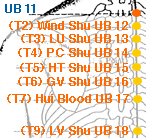UB 13 UB13 Lung Shu Fei Shu 肺俞 urinary bladder 13 Urinary Bladder 13 ub13
Back to meridian Jump to point Jump to point… UB 1 — Bright Eyes UB 2 — Bamboo Gathering UB 3 — Eyebrow Ascension UB 4 — Deviating Turn UB 5 — Fifth Place UB 6 — Light Guard UB 7 — Celestial Connection UB 8 — Declining Connection UB 9 — Jade Pillow UB 10 — Celestial Pillar UB 11 — Great Shuttle UB 12 — Wind Gate UB 13 — Lung Shu UB 14 — Jue Yin Shu (Pericardium Shu) UB 15 — Heart Shu UB 16 — Governing Shu UB 17 — Diaphragm Shu UB 18 — Liver Shu UB 19 — Gallbladder Shu UB 20 — Spleen Shu UB 21 — Stomach Shu UB 22 — Triple Burner Shu UB 23 — Kidney Shu UB 24 — Sea of Qi Shu UB 25 — Large Intestine Shu UB 26 — Origin Pass Shu UB 27 — Small Intestine Shu UB 28 — Bladder Shu UB 29 — Central Backbone Shu UB 30 — White Ring Shu UB 31 — Upper Bone Hole UB 32 — Second Bone Hole UB 33 — Central Bone Hole UB 34 — Lower Bone Hole UB 35 — Meeting of Yang UB 36 — Support UB 37 — Gate of Abundance UB 38 — Superficial Cleft UB 39 — Bend Yang UB 40 — Bend Middle UB 41 — Attached Branch UB 42 — Po Door UB 43 — Above The Diaphragm Shu UB 44 — Spirit Hall UB 45 — Yi Xi UB 46 — Diaphragm Pass UB 47 — Hun Gate UB 48 — Yang Headrope UB 49 — Reflection Abode UB 50 — Stomach Granary UB 51 — Huang Gate UB 52 — Will Chamber UB 53 — Bladder Huang UB 54 — Sequential Limit UB 55 — Yang Union UB 56 — Sinew Support UB 57 — Mountain Support UB 58 — Taking Flight UB 59 — Instep Yang UB 60 — Kunlun Mountains UB 61 — Subservient Visitor UB 62 — Extending Vessel UB 63 — Metal Gate UB 64 — Capital Bone UB 65 — Bundle Bone UB 66 — Valley Passage UB 67 — Reaching Yin
UB 13 UB13
UB 13 UB13
UB 13 Lung Shu - Fei Shu - 肺俞 Location 1.5 cun lateral to
GV 12 , level with T3.
Actions Main point for all Lung related issues from a TCM perspective - tonifies LU Qi and Yin: cough, asthma, bronchitis, sore throat, nasal congestion, shortness of breath, weakness of the voice, consumption, steaming bone disorder, etc.
Useful for skin disorders, itching, acne, hives, etc.
Lung related emotional imbalances such as grief and sadness.
Qi tonification aspects can be increased with the application of moxabustion at this point.
Back to meridian Jump to point Jump to point… UB 1 — Bright Eyes UB 2 — Bamboo Gathering UB 3 — Eyebrow Ascension UB 4 — Deviating Turn UB 5 — Fifth Place UB 6 — Light Guard UB 7 — Celestial Connection UB 8 — Declining Connection UB 9 — Jade Pillow UB 10 — Celestial Pillar UB 11 — Great Shuttle UB 12 — Wind Gate UB 13 — Lung Shu UB 14 — Jue Yin Shu (Pericardium Shu) UB 15 — Heart Shu UB 16 — Governing Shu UB 17 — Diaphragm Shu UB 18 — Liver Shu UB 19 — Gallbladder Shu UB 20 — Spleen Shu UB 21 — Stomach Shu UB 22 — Triple Burner Shu UB 23 — Kidney Shu UB 24 — Sea of Qi Shu UB 25 — Large Intestine Shu UB 26 — Origin Pass Shu UB 27 — Small Intestine Shu UB 28 — Bladder Shu UB 29 — Central Backbone Shu UB 30 — White Ring Shu UB 31 — Upper Bone Hole UB 32 — Second Bone Hole UB 33 — Central Bone Hole UB 34 — Lower Bone Hole UB 35 — Meeting of Yang UB 36 — Support UB 37 — Gate of Abundance UB 38 — Superficial Cleft UB 39 — Bend Yang UB 40 — Bend Middle UB 41 — Attached Branch UB 42 — Po Door UB 43 — Above The Diaphragm Shu UB 44 — Spirit Hall UB 45 — Yi Xi UB 46 — Diaphragm Pass UB 47 — Hun Gate UB 48 — Yang Headrope UB 49 — Reflection Abode UB 50 — Stomach Granary UB 51 — Huang Gate UB 52 — Will Chamber UB 53 — Bladder Huang UB 54 — Sequential Limit UB 55 — Yang Union UB 56 — Sinew Support UB 57 — Mountain Support UB 58 — Taking Flight UB 59 — Instep Yang UB 60 — Kunlun Mountains UB 61 — Subservient Visitor UB 62 — Extending Vessel UB 63 — Metal Gate UB 64 — Capital Bone UB 65 — Bundle Bone UB 66 — Valley Passage UB 67 — Reaching Yin
